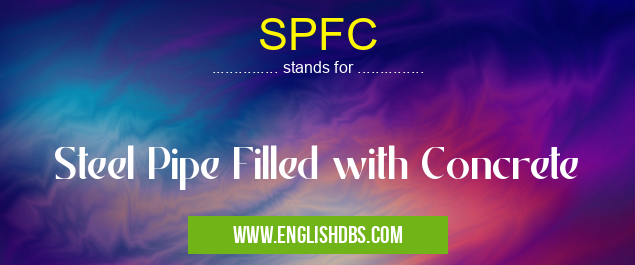What does SPFC mean in CONSTRUCTION
SPFC stands for Steel Pipe Filled with Concrete. It is a composite construction material used in various structural applications.

SPFC meaning in Construction in Miscellaneous
SPFC mostly used in an acronym Construction in Category Miscellaneous that means Steel Pipe Filled with Concrete
Shorthand: SPFC,
Full Form: Steel Pipe Filled with Concrete
For more information of "Steel Pipe Filled with Concrete", see the section below.
What is SPFC?
SPFC is a combination of steel pipe and concrete. The steel pipe acts as a formwork for the concrete, providing strength and rigidity. The concrete, in turn, fills the pipe and protects it from corrosion and fire.
Advantages of SPFC
- High strength-to-weight ratio: SPFC combines the strength of steel with the durability of concrete, resulting in a material with a high strength-to-weight ratio.
- Fire resistance: Concrete provides excellent fire resistance, protecting the steel pipe from heat and flames.
- Corrosion resistance: Concrete shields the steel pipe from environmental factors that could cause corrosion.
- Ductility: SPFC exhibits ductility, allowing it to withstand seismic and impact loads without compromising its structural integrity.
- Cost-effective: SPFC can be a cost-effective alternative to traditional steel or concrete construction methods.
Applications of SPFC
SPFC is used in a wide range of applications, including:
- Bridges: SPFC is used in bridge construction for piers, beams, and girders.
- Buildings: SPFC is employed in the construction of high-rise buildings, stadiums, and other large structures.
- Marine structures: SPFC is suitable for use in marine environments, such as docks, piers, and offshore platforms.
Essential Questions and Answers on Steel Pipe Filled with Concrete in "MISCELLANEOUS»CONSTRUCTION"
What is Steel Pipe Filled with Concrete (SPFC)?
SPFC is a composite structural element consisting of a steel pipe filled with concrete. The steel pipe provides structural strength and stiffness, while the concrete fills the pipe to enhance the structural performance, provide fire protection, and improve durability.
What are the advantages of using SPFC?
SPFC offers several advantages, including:
- Enhanced structural capacity: The concrete filling increases the compressive strength and stiffness of the steel pipe, resulting in a more robust structural element.
- Improved fire resistance: Concrete provides excellent fire protection for the steel pipe, preventing it from losing its strength and integrity during a fire.
- Increased durability: The concrete filling protects the steel pipe from corrosion, environmental factors, and mechanical damage, extending its service life.
- Architectural versatility: SPFC can be shaped into various forms, allowing for creative architectural designs.
Where is SPFC commonly used?
SPFC is widely used in various construction applications, including:
- Buildings: As columns, beams, and bracing systems in multi-story buildings, providing exceptional strength and fire resistance.
- Bridges: For bridge piers, abutments, and girders, offering durability and resistance to environmental conditions.
- Marine structures: In offshore platforms, piers, and seawalls, where corrosion resistance and structural integrity are crucial.
- Industrial facilities: For columns, beams, and support structures in factories, warehouses, and power plants, providing strength and fire protection.
How is SPFC designed?
SPFC design involves considering various factors, such as:
- Structural loads: The element must be designed to withstand the expected loads, including axial compression, bending, and shear.
- Steel pipe properties: The thickness, diameter, and grade of the steel pipe influence the structural capacity and fire resistance.
- Concrete properties: The strength, density, and workability of the concrete affect the overall performance of the SPFC element.
- Connection details: The connections between SPFC elements and other structural components must be carefully designed to ensure load transfer and structural stability.
What are the challenges associated with SPFC?
Some challenges associated with SPFC include:
- Construction complexity: Proper installation of SPFC requires specialized techniques and skilled labor to ensure proper concrete placement and consolidation.
- Quality control: Ensuring the quality of SPFC elements, including the steel pipe, concrete, and workmanship, is crucial for structural integrity and durability.
- Cost: SPFC can be more expensive than traditional structural elements due to the materials and specialized construction techniques involved.
Final Words: SPFC is a versatile composite material that combines the benefits of steel and concrete. Its high strength, fire resistance, corrosion resistance, and cost-effectiveness make it a valuable option for various structural applications.
